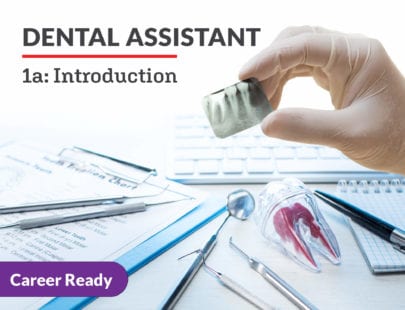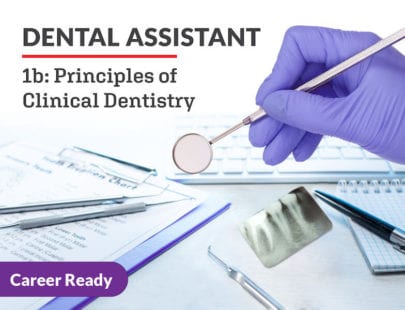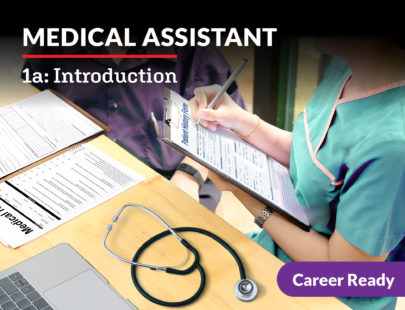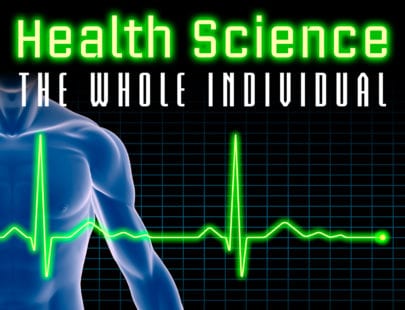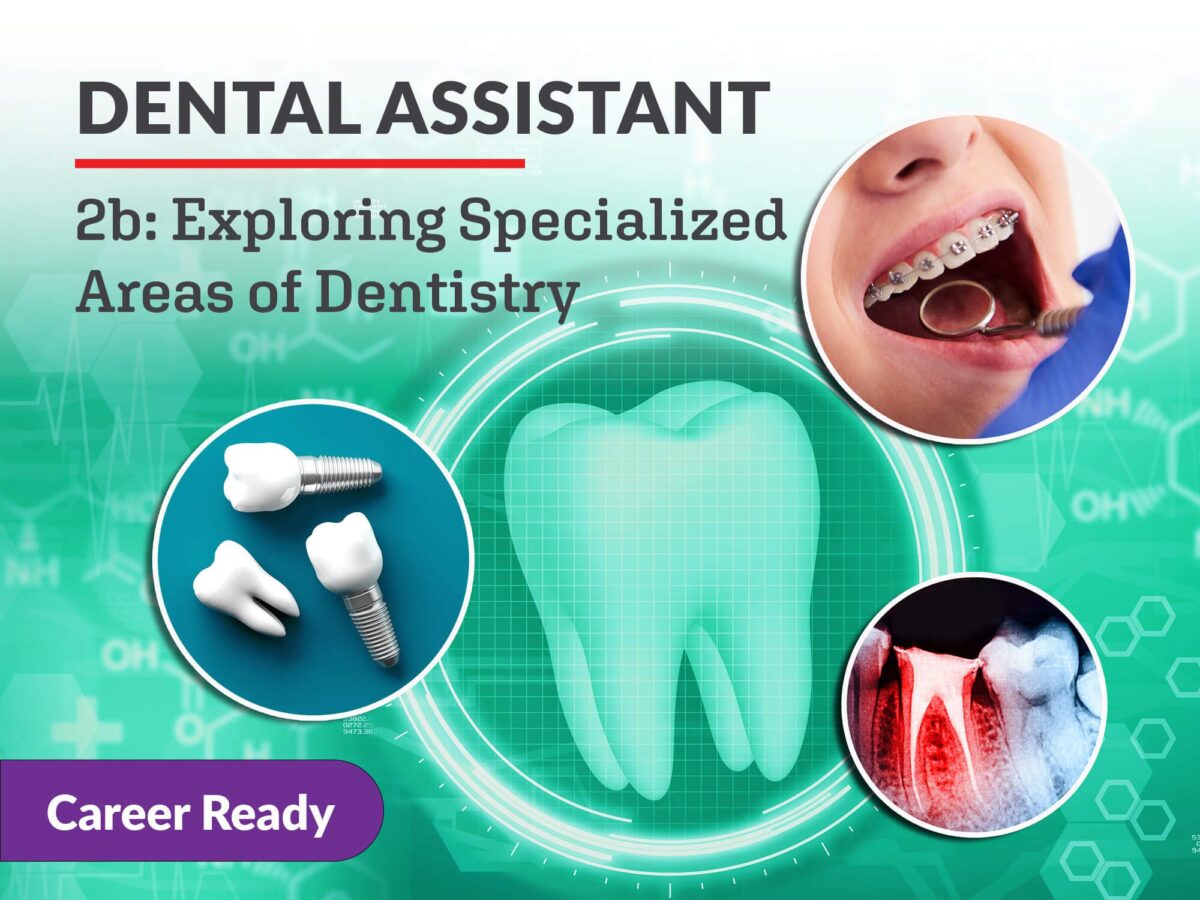
Dental Assistant 2b: Exploring Specialized Areas of Dentistry
You’ve learned dental anatomy, the structure of a dental practice, and basic dental treatments; now, it’s time to drill down even deeper into the world of a dental assistant. In this course, you’ll explore clinical subjects: maintaining safe environments for patients, managing pain and medications, using and handling common materials in a dental setting, the basics of radiology, dental specialties and more! You’ll also encounter activities designed to get you out of the classroom and into the dental world investigating and volunteering in professional settings. Lastly, you’ll learn about professional organizations, gaining employment, and the certification process. Let’s keep heading towards the apex of your future career!
Units at a Glance
Unit 1: Dental Materials
Dental materials are a crucial part of any dental procedure. The dental assistant is responsible for mixing these materials and applying them within the scope of practice. Understanding how to adequately prepare dental materials will help advance your skill level and prepare you for working in general dentistry or any specialty.
What will you learn in this unit?
- Identify organizations responsible for establishing standards for dental materials
- Describe the direct restorative and esthetic materials
- Discuss how and why various dental materials are used in the restoration process
- Classify the types of dental cement
Unit 2: Additional Dental Materials and Laboratory Techniques
There are many more dental materials to explore in the world of dentistry. From explaining whitening products to using impression materials, the role of the dental assistant continues to grow. A thorough understanding of gypsum products and laboratory procedures is also essential to help maintain the flow of a busy dental office.
What will you learn in this unit?
- Describe materials used for indirect restorations
- Discuss the use of teeth whitening products
- Identify properties and manipulate impression materials
- Explain elastomeric impression materials and their uses, mixing techniques, and applications
- List the types of equipment found in a dental laboratory and describe their uses
- Demonstrate how to pour, trim, and finish dental models
Unit 3: Radiology Basics
Radiology is a crucial part of dental treatment. Every state has its own rules and regulations that apply to a dental assistant, so understanding the law in your state is a necessary step. Dental assistants must thoroughly understand why dental imaging is needed for treatment planning. Many dental procedures rely on imaging to accurately identify and locate dental diseases. All dental professionals must be knowledgeable on safety and infection control methods used to protect both patients and themselves from exposure to radiation and cross-contamination.
What will you learn in this unit?
- Describe the basic concepts of radiography
- List the components of the dental x-ray machine
- Define the characteristics of the x-ray beam
- Explain radiation safety, including the ALARA concept
- Identify the components of a quality assurance program
- Discuss infection control as it applies to the various stages of taking a radiograph
Unit 4: Radiographic Techniques and Digital Radiology
Dental x-rays are a great tool for any dentist to diagnose and treat a patient. However, the images produced must be of diagnostic quality in order for damage or disease that isn’t visible to the naked eye to appear. When used improperly, this tool reveals nothing more than a grainy, black-and-white blur—which effectively renders it useless because without a clear image a diagnosis cannot be made. As with many other functions in the dental office, the dental assistant plays an important role in this proactive approach to identifying and treating issues in the oral cavity.
What will you learn in this unit?
- Identify the five basic sizes of dental film
- Discuss the steps of film processing and common errors that occur
- Differentiate between the two primary techniques used for intraoral imaging
- Describe the two methods of mounting intraoral images
- Define panoramic extraoral imaging
- Explain digital radiography
Unit 5: Pediatric Dentistry and Orthodontics
The pediatric dentist and orthodontist work closely together to formulate treatment plans for children and adolescents. Many of the same techniques are used in both offices, but they utilize different instruments. If you enjoy being around kids, working as a dental assistant in either a pediatric or orthodontic office could be a highly rewarding place of employment that just may be your perfect fit!
What will you learn in this unit?
- Describe the appearance and setting of a pediatric dental office
- Discuss the types of pediatric dental treatment
- Differentiate between the types of malocclusion
- List the types of records used to assess orthodontic problems and prepare treatment plans
- Explain the procedure for cementing orthodontic bands
Unit 6: Periodontics and Prosthodontics
Periodontics and prosthodontics are two dental specialties full of various procedures to challenge dental assistants’ skills. Assisting chairside, mixing dental materials, and taking impressions are just a few things you’ll learn about working within these specialties. You are about to discover how these two specialists can transform a patient’s smile and help them gain control of their oral health.
What will you learn in this unit?
- Name instruments used in periodontal therapy
- Discuss nonsurgical and surgical periodontal treatment options
- Identify prosthetic dental restoration
- Describe the steps of a bridge procedure
Unit 7: Endodontics and Oral Maxillofacial Surgery
Endodontics and oral maxillofacial surgery are two dental specialties that require additional training and skills to use specialized instruments. The dental assistant works directly with the dentist preparing sterile environments, transferring instruments, and monitoring the patient during procedures. Working in one of the specialized fields allows you to see how diseased tissues are removed from the mouth, thereby restoring balance within the oral cavity.
What will you learn in this unit?
- List the types of pulpal damage
- Identify the instruments and accessories used in endodontics
- Discuss specialized instruments used for basic surgical procedures
- Describe postoperative care given to a patient after a surgical procedure
Unit 8: Dental Public Health and Other Specialties
The world of dentistry is always changing. New specialty areas are gaining recognition, expanding the career path for dental assistants. Along with these new career paths, there are numerous opportunities for dental assistants to learn leadership skills and take on leadership positions. Many times, developing these essential skills begins with involvement in student organizations.
What will you learn in this unit?
- Identify and describe public health dentistry
- Describe oral and maxillofacial radiology and pathology specialties
- Discuss dental aesthesia, orofacial pain, and oral medicine
- Explore the various employment opportunities and career growth potential in dentistry
Required Materials
Physical
- Audio recording device
- Containers or bowls
- Cutting utensil
- Index cards
- Molding supplies
- Phone
- Various household items
- Video recording device
Software
- Word processing software
- Presentation software
Other
- Helper
Optional
- Art supplies
- Binder
- Digital camera
- Google Drive
- Graphic design software
- Online website builder
- Poster board
- Presentation software
- Printer
- Thumb drive
